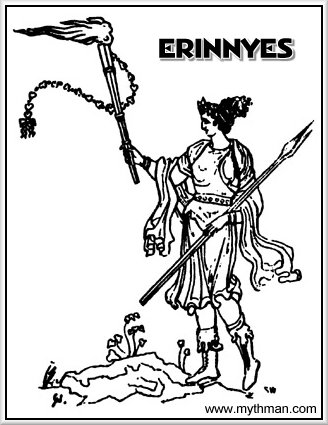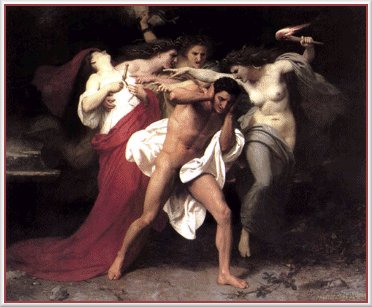ERINNYES
"The Angry Ones"
(ROMAN - The Furies, Furiae or Dirae)

A Fury, goddess of punishment, shown with a torch,
scourge and spears, the tools of her vengeance
(Illustration from Dr. Smith's Classical Dictionary, 1895)
Myth Man's Award-winning Homework Help
ERINNYES
"The Angry Ones"
(ROMAN -
The Furies, Furiae or Dirae)

A Fury, goddess of
punishment, shown with a torch,
scourge and spears, the tools of her vengeance
(Illustration from Dr. Smith's Classical Dictionary, 1895)
|
The Erinnyes (also spelled Erinyes) were "the Angry Ones", known as the Furies in Roman. They were the feared avenging goddesses in Greek and Roman mythology who were born from the falling drops of blood of Uranus (Sky) when he was mutilated by his son, the Titan Cronus. The drops fell on Mother Earth (Gaea) and impregnated her. "...and Cronus cut off his father's genitals and threw them into the sea; and from the drops of the flowing
blood were born Furies, to wit, Alecto, Tisiphone, and Megaera." Other versions of their birth claim that they were the daughters of Mother Earth and Darkness, or of Nyx (Night), or the Titans Cronus and Eurynome (and thus sisters to the Moerae, the Fates). One of their famous victims, Orestes, gave them the name 'Eumenides', the 'Solemn Ones', or 'Kindly Ones'. More on Orestes below. Their home was at the entrance to Tartarus, that infernal place deep in the Underworld where the souls of the condemned were exiled, a gloomy place in Hades as far distant from earth as earth is distant from the sky. Others call their home Erebus, the darkest pit of the Underworld. There, the Erinnyes would screen out those unfortunate doomed who had yet to atone for their sins, relentlessly tormenting them. No prayer, no sacrifice, and no tears could move them, or protect the hapless object of their persecution; and if ever they felt that the criminal would escape them, they called in the assistance of the goddess Dike (Justice). The Erinnyes were closely connected to Dike, for the merciless maintenance of strict justice was their utmost concern. What did they look like? Often they were depicted as repulsive winged female creatures wearing black robes. Other descriptions adorned them with snakes twined in their hair, piercing red eyes dripping blood, pitch-black bodies with bat wings, and even sporting the heads of dogs. Definitely not a posse you'd want on your case... In works of art and on the stage, however, their fearful appearance was greatly softened down, and they were represented as solemn and purposeful maidens, wearing the richly adorned attire of huntresses, with a band of serpents around their heads, and serpents or torches in their hands. Because nobody really wanted anything to do with these avenging creatures, mortals rarely referred to the Erinnyes by name, in case they invoked their wrath. Instead they were often euphemistically called the aforementioned Eumenides, the 'Kindly Ones' or 'Solemn Ones', the term coined by their hapless victim called Orestes.
There were usually said to be three Furies (note: At Athens there were statues of only two), called Alecto, Tisiphone and Megaera, but quite often they were depicted as a large flock of flying creatures, with the three named members leading the avenging pack. The Harpies, who were filthy, monstrous, vulture-like female beasts loathed by humans, often served the Erinnyes in capturing or tormenting those unfortunate people who had displeased them. Portrayed with and without wings, the Erinnyes in time became better known as those responsible for avenging offenses by children against their mothers, and eventually came to be the divine punishers - along with Zeus - of anyone who committed perjury or patricide (killing of one's father). As their influence spread, the Erinnyes became the personification of the concepts of vindictiveness and retribution (also see Nemesis), and represented the psychological torments associated with a guilty conscience. Eventually their influence extended to the hearing of complaints of insolence by the young toward the old; punishing disrespect of parents by their children; as well as lack of hospitality to guests by their hosts, a terrific breach of ancient etiquette.
In short, if you messed up, the wicked fury of the Erinnyes was not far...There were many who incurred the wrath of the Furies, with catastrophic results. Some of their more famous victims included Orestes, Oedipus, Alcmaeon, and even the Amazon Queen called Penthesileia. What did these perpetrators do to arouse the anger of the Erinnyes? Orestes murdered his mother and was relentlessly hounded by the Furies. Eventually Orestes begged Athena for redemption, going to her temple on the Acropolis of Athens and embracing her image. After a trial, Orestes was declared not guilty by the Olympian gods, but the Erinnyes threatened to let fall a drop of their own blood on earth, which would kill the plants and crops and destroy the people of Athens if the ruling stood. Athena convinced the Erinnyes to take up residence in a grotto at Athens, where they would be worshipped by the citizens. Bribing them with offers of great honor, Athena was able to placate their vengeance, and the three named Furies finally agreed to stop tormenting Orestes. However, some say that the rest of the winged pack of Furies continued to harass and pursue Orestes, until he finally managed to appease them by offering a sacrificial black sheep at a place called Carneia. A grateful Orestes then named them the Eumenides ('Solemn Ones', 'Kindly Ones') and dedicated a new sanctuary to them.
What about some of their other victims?
These were but a few of the targets of their terrible vengeance. People were justifiably terrified of these timeless crones. Tisiphone, Alecto and Megaera were older than Zeus or any of the other Olympians, and were therefore not quite under the rule of Zeus, though they honored and esteemed him. They acted on complaints and punished the transgressors, relentlessly hounding the culprits. Nobody could escape from their wrath -- they pursued their victims from city to city and country to country, without rest or pause. They carried brass-studded scourges in their hands, inflicting a terrible torment on their victims. Feared and revered by the ancients, the Furies were mythology's personified avenging spirits. The sacrifices which were offered to them consisted of black sheep and nęphalia -- a drink of honey mixed with water. The objects sacred to them included white turtledoves and the narcissus flower. A festival called the 'Eumenidia' was celebrated in their honor at Athens, where they had a sanctuary and a grotto near the Areopagus. Another sanctuary, with a grove which no one was allowed to enter lest the Furies' wrath was aroused, existed at the city of Colonus. They were also worshipped at Megalopolis, where they were known under the name of Maniai (Mania).
Here's some interesting material from Harry Thurston Peck: The name Erinys, which is the more ancient one, was derived by the Greeks from the verb erinô or ereunaô, “I hunt down,” or “persecute,” or from the Arcadian word erinuô, “I am angry”; so that the Erinyes were either the angry goddesses, or the goddesses who hunt or search for the criminal. The name Eumenides, which signifies “the well-meaning,” or “soothed goddesses,” is a mere euphemism, because people dreaded to call these fearful goddesses by their real name; and it was said to have been first given them after the acquittal of Orestes by the court of the Areopagus, when the anger of the Erinyes had become soothed. It was by a similar euphemism that at Athens the Erinyes were called semnai theai, or the Revered Goddesses. From Harry Thurston Peck, Harpers Dictionary of Classical Antiquities (1898) |

Orestes tormented by the
Erinnyes for killing his mother
Web, myth narration & graphics
created & maintained by Nick Pontikis
Copyright © 1995 - 2010 Thanasi's Olympus Greek Restaurant
The Myth Man persona © 1988 Nick Pontikis
Copyright © 1999 mythman.com